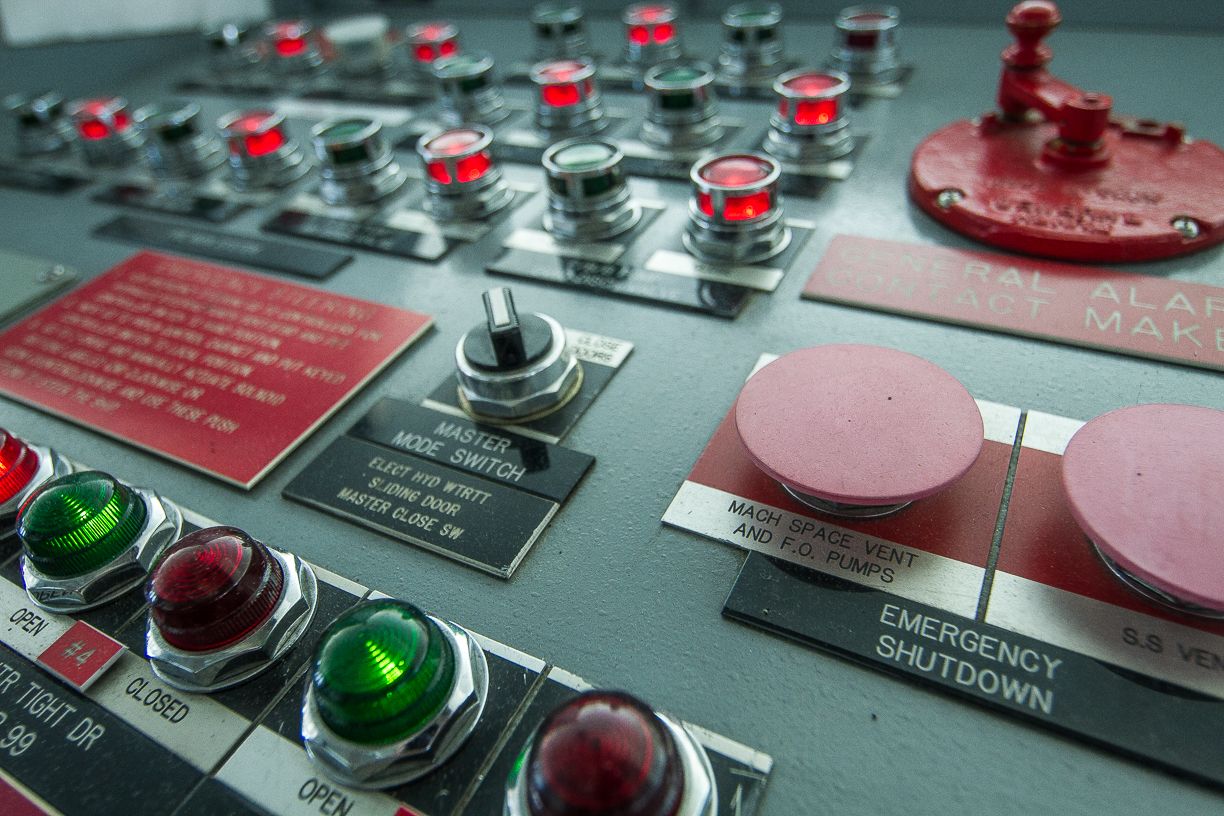Apologies in advance to the disproportionate number of psychiatrists I play and have played RPGs with.
The Ship’s Computer
A good ship’s computer can elevate a sci-fi story. Holly, Hera, HAL 9000, and MOTHER all play in the spaces between free-willed and program-bound, crewmate and antagonist, being and place. Even ship’s computers without such “human” interfaces can become recognizable characters, like the TARDIS or Deep Space 9’s “Computer.”
 Maintaining the ship's computer. (US DOD)
Maintaining the ship's computer. (US DOD)
At the same time, “realistically” translating one to a game is difficult, and questionably worthwhile. As a player option, the ship’s computer is lacking and as an NPC it seems most reasonable to play them normally.1
Taking a page from Breakdown, I thought I would examine the structure of a hypothetical AI in practical, comprehensible terms.2 This required surprisingly little extrapolation because I simply do not care if I am making incorrect predictions or misunderstanding the state-of-the-art. My goal here is only to discover interesting quirks and flaws in the system that could be expanded into opportunities for gaming.
That said, the structure here is not limited to (or even intended for) Breakdown. It’s probably still functional for non-ship AIs, in the vein of WOPR, Hex, or GLaDOS. But I wouldn’t use it for anything smaller or faster, like Data or a Tachikoma. The goal is not that this structure informs the role-playing of the AI directly.

Sensor Array
Reference: A cell phone.
The sensor array includes, roughly, all the sensors in your cell phone (cameras, antennas, microphones, accelerometers, gyroscopes, magnetometers) and all the inputs to a standard BAS (temperature, pressure, occupancy, doors, inventory, levels, equipment status). These are all combined with the current outputs and pre-processed with an attention-optimizing filter.
Notes: The filter is susceptible to noise and has limited bandwidth. Rapidly-changing unpredictable values in one channel can easily “drown out” another channel.
The Id Core
Reference: ChatGPT.
The Id Core is the ultimate achievement of black-box deep neural net design: a machine so complex that the output might be considered genuinely insightful.
Notes: This thing is basically chatGPT 2000. If you’ve played with chatGPT 4, you can guess what that means, but if you haven’t had the chance, I’ll elaborate: it’s confident, biased, creative, dumb, intuitive, suggestible, and often wrong.
The Super-Ego Core
Reference: Any video game with a stock “you can’t do that” reply.
The Super-Ego or SE Core is a more “traditional” AI, with the role of thinking critically and logically, although it’s generally pretty “dumb.”
Notes: It freely delegates to three subsystems and organizes their responses.
Data Banks
Reference: Wikipedia.
The SE Core can query its extensive knowledge and use that in its decision making. Unfortunately, there is no way for it to tell things directly to the Id Core.
Notes: Updating the SE Core’s data banks is closer to buying a new encyclopedia than to editing Wikipedia. Well-maintained corporate ships might get annual updates, but it’s not uncommon for a freelancer’s computers to have data banks ten or twenty years out-of-date. (This is separate from what may be stored as “data.” A ship could look-up correct information elsewhere, but the SE Core still would not be able to reason about it.)
Logic Unit
Reference: Wolfram Alpha (when it was good), a scientific calculator.
The Logic Unit handles analytic, numeric, and qualitative solutions to all manner of mathematical and engineering questions.
Notes: The Logic Unit will “get distracted” by any simple paradoxes that may slip through the SE Core’s checks, and need to be manually reset.
Ethics Drive
Reference: The worst “technically correct” type of person you know.
Ethics Drives are smaller networks trained on careful diets of philosophy 101 textbooks, compliance manuals, employee handbooks, and legal codes.
Notes: Ethics Drives are residually sensitive to corporate and regulatory logos. If it sees an NFPA placard, it will start to prioritize fire codes, but if it sees the EPA logo it may be more concerned about the possibility of unpermitted emissions.
The Ego Core
Reference: A person.
The Ego Core is where the magic happens, the necessary weasel3 of this architecture. In principle, the Ego Core mediates between the demands of the Id and SE Cores and translates them into useful output. To many people, this is the “personality” of the ship, but of course it’s more complicated than that and it can’t do anything without this supporting infrastructure.
The Ego Core is also responsible for handling direct inputs, like user requests, mission objectives, and “learned” information, which are only passed to the Id and SE Cores indirectly and periodically cached.
Notes: Here’s where you can put whatever you want! I might put fungus here, or a crystalline McGuffin, or “quantum.”
Outputs
Reference: Another cell phone.
The AI has outputs more-or less corresponding to its inputs in the Sensor Array. It can output audio, video, radio, and text. It can also make changes in navigation, HVAC, and security systems.
Notes: The computer may require human assistance to interact with arbitrary systems on-board the ship, such as aftermarket additions or laboratory computers. Even if it is physically connected and allowed security permissions, its output filters aren’t built to directly interface with other machines. So it could write a program, but could not “push” it and run it by itself.
Overrides
Reference: Equipment lockout/tagout procedures.
Despite its ease of use and sophistication, the override system operates at a very low level, intercepting and replacing invalid outputs.
Notes: It’s not a good idea to use overrides that contradict a current input, or the Id and SE Cores will become “frustrated” and start trying to circumvent them. Eventually you’ll need to update the input caches of the two cores (an offline process).
Other systems & linkages
The operation outlined here is broadly correct, but can’t begin to cover all the other systems on a spaceship. Some of these might include:
- crew file storage
- arbitrary computing resources
- laboratory computers
- weapons systems
- medical computers
And all of these have varying degrees of connection and integration with the Ship’s AI. I’ve detailed two of these “pseudo-attached” systems below.
Logs
Reference: Computer logs.
The AI logs contain all of the data received and sent during the AI’s decision-making process. For reasons of space, older data is reduced in detail and density.
Notes: The logs require a separate Historian AI to decompress and interpret (colloquially called a “ship’s therapist”). These are not usually kept on-board.
The Hind
Reference: A PLC.
The hind runs all the low-level ship stuff without any direct input, even when the rest is offline. The AI seldom actuates things directly, much easier to change a setpoint in the Hind.
Notes: It’s tedious, but re-tuning all the loops on your ship will probably make noticeable, if minor, improvements throughout. Without these periodic (and frankly rare) efforts, the AI will simply compensate for increasingly drifting controls on-the-fly.
 Manual interfaces. (NAAMES Photo Essay)
Manual interfaces. (NAAMES Photo Essay)
“Normally” as opposed to “with a gimmick,” like the duergar flowchart or an online simulation. I think this is especially the case if you plan to have the same ship’s computer appear multiple times.↩︎
Breakdown is a weird and fascinating game that I hope to write more about in the future.↩︎
Currently, TVTropes has merged this into the more universal “Acceptable Breaks from Reality,” but this obscures the origin of the phrase. Roughly, the argument goes: somewhere, even the hardest of sci-fi has to do some hand-waving, or else it wouldn’t be sci-fi, it would just be possible. So as you dig down into the physics of a world or the mechanics of something, eventually you hit bedrock: the necessary weaseling that enables the whole thing.↩︎